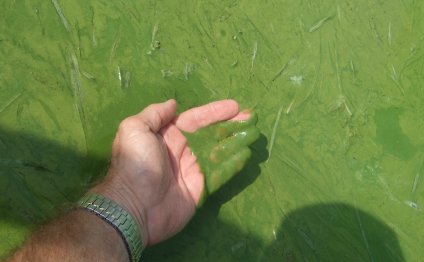
Water pollution in Lake Erie
5 | Lake Erie: "We have met the enemy and he is us"*
In the 1960s, Lake Erie was declared "dead, " though, ironically, it was full of life - just not the right kind. Eutrophication had claimed Lake Erie and excessive algae became the dominant plant species, covering beaches in slimy moss and killing off native aquatic species by soaking up all of the oxygen. The demise of Lake Erie even made it into a Dr. Seuss book, The Lorax.
Lake Erie is the shallowest and warmest of the five Great Lakes, and the basin is also intensively developed with agriculture, urban areas, industries and sewage treatment plants. For decades, pollution filled Lake Erie with far more nutrients than the lake could handle, with phosphorous being the main culprit. Phosphorous is a fertilizer that induces plant growth and algae and was also found in many commercial detergents at the time. Plants began growing, dying and decomposing in Lake Erie, creating anoxia (severe deficiency of oxygen) at the bottom of the lake and leaving the water's surface putrid and mossy. The lack of oxygen killed fish and other aquatic species, and the smelly surface repelled anglers, tourists and those living around Lake Erie. Heavy metals also had contaminated much of the fish population of Lake Erie.
In response to public concern and recommendations by the International Joint Commission, the Great Lakes Water Quality Agreement was signed by the United States and Canada in 1972. The Agreement emphasized the reduction of phosphorous entering lakes Erie and Ontario, and in 1977 maximum levels for phosphorous were added to the Agreement. Also, phosphorus in detergents was finally banned. Coupled with the U.S. and Canadian Clean Water acts, the GLQWA did much to reduce the phosphorus levels in Lake Erie.
Today, phosphorus loads in Lake Erie are now below the maximum allowed in the GLWQA, and eutrophication has been controlled. Algae and excessive plant growth has been reduced, and native plants are once again growing in sections of the lake. Lake Erie still has many problems - such as non-native invasive species, contaminated sediments and closure of beaches due to sewage contamination. But, through international cooperation and public advocacy, the lake is no longer considered "dead, " and, hopefully, people have a better understanding and concern for the effects of human activity on water quality in the Great Lakes and beyond.
Share this Post
Related posts
Fish found in Lake Erie
Local Fishing Categories Panfish: Simply put, there is nothing more enjoyable to fish for – be it for the youngsters or the…
Read MoreList of fishing in Lake Erie
So the famous statement holds true: A bad day of fishin is better than a good day of work (author unknown). When I think…
Read More









